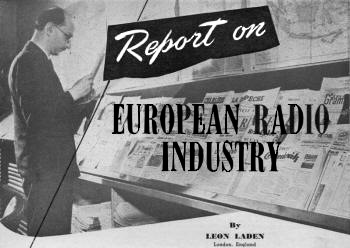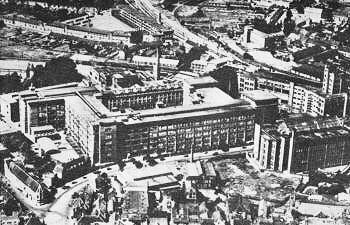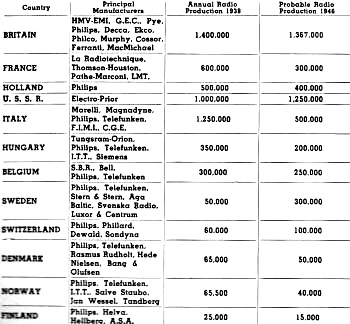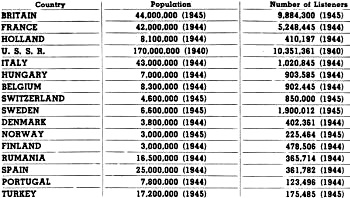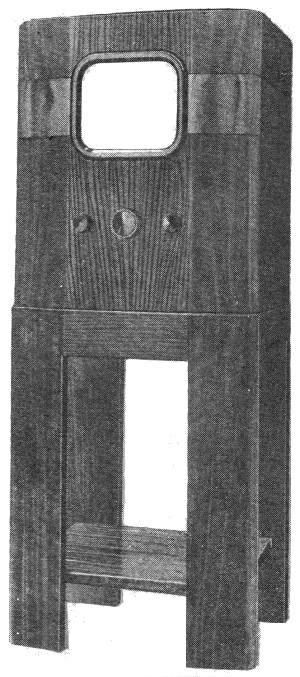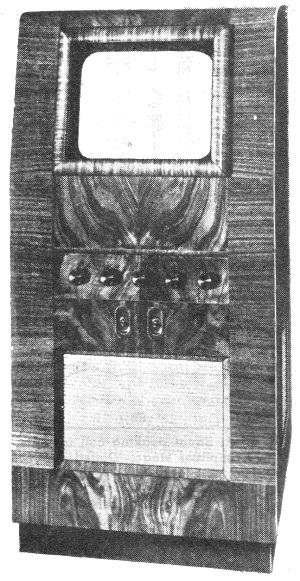Report on the European Radio Industry |
|
By 1946, radio and television manufacturers were scurrying to supply the huge, pent-up demand for communications and entertainment systems that accumulated during World War II. Fortunately, the dearth of electronics components, raw materials for chassis fabrication, and available labor was suddenly and significantly turned around by late 1945. Wanton destruction of entire cities in Europe left citizens without many basic creature comfort items like radios, televisions, refrigerators, vacuum cleaners, toasters, automobiles, and other things taken for granted a decade earlier. As with any well-executed plan, manufacturers endeavored to survey the market demand for such products and then devised a way to satisfy that demand. Radio News magazine published a synopsis in mid-1946 of the state of the radio and television industry in Europe so that companies in both the U.S. and in Europe could gauge the effort that would be required. Report on the European Radio Industry London, England United States manufacturers, anxious to evaluate the absorption capacity of overseas markets for their postwar production outputs, are presented here with a factual and up-to-date picture of Europe's present-day supply and demand position in the radio and television field. In Europe, as much as in the United States, manufacturers of radio equipment are making prodigious efforts to catch up with accumulated demands for domestic radio and television receivers created by the long years of scarcity. But while the volume of American radio production is slow in starting it may by the end of the year reach a staggering total (completed units) topping the 10 million mark recorded for 1939.1 The necessarily incomplete figures available for measuring, with any degree of reliability, the current output of European radio production leave but little doubt of its utter incapacity to surge ahead and approach the comparable figure of 8 million receiving sets. This divergence in the respective levels of output between the U. S. and European radio production is partially accounted for by the disruption of all types of civilian production due to hostilities, and the overriding needs for housing, food, clothing, and other necessities. At the same time, however, it is also due in part to the fact that the American radio industry is a highly concentrated and efficient industry with an enormous home market, while the European radio industry, dispersed over many countries and forced to purchase parts in a closed market from firms with a monopoly position, is one of the most woefully backward and grossly inefficient industries in existence over here. The Philips' factory at Eindhoven, Holland. Before the war this plant produced a high percentage of the European radio tubes. In fact, according to investigations conducted recently by Ian Mikardo, a well-known British production expert and member of Parliament, European radio production costs, despite considerably higher American wages, are invariably well above those in America, but comparable manpower efficiency figures average out nearly five times lower in the U. S. than in Britain, eight times lower than in France and much lower still than in Russia. Of course, the economic utilization of labor cannot be regarded as the sole criterion of industrial efficiency and figures comparing output per operator, necessarily and admittedly compiled on the basis of approximations and conjectures, must be taken with a good many reservations even in an industry such as the radio industry where undoubtedly a high proportion of the final production cost is represented by labor cost. In particular, it must be borne in mind that the American radio industry managed to increase its output per operator-hour through the installation of special mass assembly line machinery, geared to produce enormous quantities of standardized midgets, car radios, pocket radios, portable radio-phonographs, personal portables and similar items which are of a design, size and shape less cumbersome to make and offering greater economy in production than table and console models which are principally in demand in Europe. Moreover, apart from the quantity of sets turned out per operator, quality, durability and the differing marketing conditions operative in European countries must also be taken into consideration. If this is done, it might appear perhaps less inefficient than sometimes assumed to make receivers that take longer to construct but strike a balance between production requirements and the consumers' demand for radios lasting longer and needing less repair or maintenance. Nevertheless, it is fully realized over here that if the radio industries of the various European countries wish to take the brake off production and hold their own against outside competition, their efficiency levels will have to be raised substantially and slackness, incompetence, obsolete plant or outdated methods done away with. That this is generally understood is evidenced by the present planning trend sweeping the continent and changing the traditional production patterns of its industries. This trend, engendered, guided and financed by the governments of most of these countries, notably Britain and France, aims at creating centralized, state-controlled agencies canalising the allocation of factory floor-space, stocks of machine tools, raw materials, labor and capital investment to manufacturing groups producing drastically reduced types of standardized and stereotyped models from single factory units. Comparison Between U. S. and European Standards These comparative production figures for radio receivers are indicative of Europe's 1946 production potential as compared to their pre-war output. In a way, this continent is effectively enlarging upon a trend of production policy which originally started at the time of the American invasion of the European radio market after the economic crisis of 1930, when such U. S. manufacturers as HMV, Philco, and I.T.T. established branch factories overseas, and the U. S., due to her superior production facilities, began to exercise a rapidly growing influence on European radio production standards by providing the lion's share of radio importations in the different countries. This resulted in U. S. receiver construction ideas, methods, and techniques being studied and copied so assiduously and faithfully over here that it is hardly possible nowadays to discern any marked difference between domestic radio sets manufactured in the U. S. and in Europe; especially since new developments on one side of the Atlantic have always been followed, almost immediately, on the other side, producing in time a uniform design and construction pattern irrespective of the country of origin. Obviously, there do exist salient features distinguishing radio sets made in either of these two hemispheres, conditioned as much by the differing transmitting facilities (with one or two exceptions, all European broadcast transmitters are state-controlled or semi-state-controlled) as the different listening habits of the public. These features, however, can be summarized as being primarily related to practical issues and, apart from comprising such minor internal layout and build-up differences as the presence or absence of tuned high frequency bands, the number of intermediary stages or the sizes of loudspeakers, concern the more exacting requirements of European listeners for outward appearance, safety of operation and length of service as opposed to the American listeners' demand for ease of operation, accessibility or streamlining. Especially the "life" expectancy of sets are different over here, and a European invariably expects a receiver, once bought, to give satisfactory service for a period of time varying from anything up to eight or ten years, while the U. S. citizen normally is accustomed to discard his radio after a couple of years of service, and then replace it with a more up-to-date model. In contrast to the American public, people in Europe are averse to investing in eye-catching or ornamental receivers and are against buying radios with frequency-numbered, clock-like scales, as well as being almost totally indifferent about internal construction or tube types. Again, push-button and remote-control refinements and similar gadgets are hardly of the same commercial value in attracting the dilatory radio purchaser in Europe as in the States. Rather, of far greater and more decisive importance is the possibility of using a second loudspeaker, the provision for waveband changers, adaptability to different current supplies, a linearly arranged scale with readable station names, a housing built in good taste architecturally, and the color of the cabinet. Europe's Manufacturing Potential Breakdown of European population, by country and number of radio listeners. Estimated 1946 television receiver production as compared to the number of sets in operation pre-war. Figures available for only those countries listed. European map broken down into four distinct areas (East, South, North, West). Radio receivers designed to be marketed in each of these areas must meet certain specific economic as well as technical requirements in order to be acceptable to the populace. The state in which the respective radio industries of the European Continent find themselves today differs, naturally, with the differing political, social, economic or industrial conditions existing in the countries in which they are located. Thus, for example, the once powerful German radio industry, which at one time claimed to have provided 75 percent of Germany's population and approximately one quarter of that of the rest of Europe's listening public with radios, and the less substantial and efficient Italian and Hungarian radio industries have all three made their exit for the time being. On the other hand, vigorous radio industries, capable of ministering to their own needs on an almost self-supporting basis, have sprung up during the war in some countries, once almost entirely dependent on foreign importations, i.e., Switzerland. A worthwhile radio industry has been created in Sweden, a country with a long tradition in the manufacture of low-current apparatus, and is now making speedy headway as an exporter, on a limited scale, to other Scandinavian countries like Norway, Denmark and Finland, in which special safety regulations prohibit the sale to the public of sets not officially approved. In predominantly agricultural countries and countries in which the general process of industrialization still remains in its infancy (Czechoslovakia, Poland, Rumania, Yugoslavia, Turkey, Bulgaria, Greece or the two countries on the Iberian Peninsula, Spain and Portugal), the pre-war picture has hardly changed at all and radio production, virtually non-existent before the war, has not materially developed beyond the original stage of making crude crystal detectors of the cat-whisker type and simple amplifying devices. Great Britain Of all these countries, Great Britain is probably the most important radio manufacturing country in Europe today with the largest number of receivers per capita and a manufacturing potential which, increased proportionally with war-time demands and based on a home market expanded to 10,000,000 sets, is qualitatively, as well as quantitatively, fully geared to compete for the $480,000,000 worth of radio and television purchases and re-placements this country will need during the next five years, according to Sir Raymond Birchall, Director-General of the British Post Office. Moreover, Britain's radio equipment manufacturers, who once exported their surplus output principally to British Dominion and Empire countries, and neglected or paid very little attention to the possibilities of marketing in Europe, are today making a determined bid to capture a fair share of the continental market with cooperatively produced, commercially profitable, radios and a coordinated export merchandising policy supplemented by improved overseas marketing. It certainly looks as if the British radio exporters mean business, because at a time when nearly every set in the country needs a repair of some kind and BBC estimates show that 1,300,000 receivers are completely out of commission and 2,500,000 partially inoperative, the British Board of Trade has announced. that of the 1,367,000 radios which are scheduled to be made by the end of 1946, 878,000 will be earmarked for the home market and 489,000 exported as against the average annual output of 1,400,000 sets before the war of which 66,000 only were exported. Presumably with an eye on this market there are now rolling off British production lines well proportioned medium-class, push-buttoned table sets with carefully arranged amplification stages, excellent tonal output and well-matched loudspeakers; more expensive cabinet type receivers with automatic recorders and record players; as well as low-priced, multi-band superhets of restricted range. Invariably, these new models contain improved tubes, components and frequency-stabilized tuned circuits and are housed in plastic cabinets. The prices charged for these radios are at present between 25 and 30 percent above pre-war levels but decreased production costs, combined with design simplifications, are expected to bring down overhead expenses and make them available to Europe's lower income groups. France In spite of an almost equal population, France's listening public is way behind Britain's and her radio industry - today gradually recovering from the effects of the war - smaller and less organized. This is due mainly to the fact that the French radio industry - apart from such Dutch, American or British controlled concerns as La Radiotechnique, French Thomson-Houston or Pathe-Marconi - consists literally of thousands of independent workshop-like factories making custom-made receivers differing in little else but scale formations and similar minor details. In order to put this radio industry on a sound basis, a comprehensive plan has been worked out and is now being brought into operation under the patronage of the French Government's overall industrial $800,000,000 "Plan Council" scheme, entailing the rejuvenation of the industry within five years through the concentration of its manufacturing potential in groups of factories that will make strictly standardized sets of a limited number of types. To satisfy the taste of the French, renowned for their individuality and reluctance to uniformity, a small number of radios will continue to be imported from abroad. It is estimated that during the five years' period, a target figure of 6,000,000 sets will be reached, and the 1938 output within two years. The cost of these receivers will probably be, in the initial stages, higher than before the war due to higher wages, increased raw material prices and inflated overheads. Holland With its international ramifications in Britain, France, Germany, Italy, Hungary, Sweden, Finland and most other European countries, as well as branch factories in the U.S.A., Australia, Argentine, and elsewhere, the Dutch Phillips concern of Eindhoven, has undeniably contrived to make Holland, in spite of its physically limited home market, one of the most important radio manufacturing countries in the world. Still hampered by lack of essential raw materials, a depleted labor force and the destruction wrought to buildings and machinery, the Eindhoven works, the biggest of its kind in Europe, is today swinging into production at a steep pace and probably soon will have reached pre-war levels of output. The Soviet Union Sprawling across nearly one-sixth of the world's land surface, a sweep of the earth containing all the raw materials required for the production of radio equipment, the U.S.S.R. occupies a special position among Europe's radio manufacturing countries, due as much to her geographical location as to the fact that the Russian radio industry is conducted along strict state-monopoly lines. At present, this relatively small industry is concentrating on the mass production of single-band, 3 tube, straight receivers, 4 tube, 3 band, t.r.f. sets and 4 tube superhets, all housed in wooden cabinets. Technically, these radios follow American construction and layout more than European and tubes and components are usually either direct copies produced in the country under license or else adaptations of other versions. Measured in relative purchasing power, prices of sets are rather high just now, due to the supply lagging far behind the demand, and despite enormously increased production programs for the future, will continue to be so until more pressing needs are met and a measure of normality has returned to this Nazi-seared country. Television in Europe Today
Television adapters of the type popular in England. Ordinary broadcast receivers are used in conjunction for the sound.
A modern British television receiver. Complementary to manufacturing sound broadcasting equipment, the European radio industry, like the radio industry of the U.S., early embarked upon the making of domestic television receivers. Of all European countries, however, Great Britain alone maintained regular television transmissions, relayed to some 20,000 set-owners, before the war; neither France, Germany, Russia nor Italy could claim similar services at that time and the number of sets in operation in any of these countries never rose above 10,000. The position is not materially changed today, and Britain is still well in advance of other countries in the manufacture of television receivers as her manufacturers, fully awake to the dangers of being scooped in the international television markets by post-war competition, at an early date carried out the preliminary spade work necessary for putting into production the blue-printed prototypes of the models now coming into the market at the rate of a few dozen at a time. It has been confidentially estimated that even present acute shortage of cathode-ray tubes will not prevent the total number of telesets in operation in this country from increasing to at least 50,000 by the end of 1946. Basically, these receivers are of a similar quality as pre-war models, and are sold at prices ranging from $180 for small-sized units to about $300 for full-sized screens. The higher priced, four-in-one combination sets comprising sight and sound with phonograph and automatic recording retail at approximately $700. France, too, has made progress in television receiver manufacture in recent years, and table models equipped with dual dials for vision/sound adjustment and synchronising/brightness control are scheduled for release shortly to the public at popular prices. Similarly, Russia, Switzerland, Italy, Holland and Belgium - countries which have either resumed television production or else are contemplating its commencement in the near future - are today making efforts to build up markets for telesets. Since the popularity of television is governed to a large extent by the cost of purchasing receivers, unit sales will be precluded from rising appreciably above pre-war figures by the material impoverishment of Europe, as long as prices are maintained at their present levels; a glance at the income structure of even Britain, a country still enjoying the highest standard of living in Europe, shows that 85 per cent of her net national income is in the hands of families with incomes below $2.000 per annum. Accordingly, it can be taken for granted that the lower income groups of Europe will not be able to command the use of television unless their purchasing power is raised or prices reduced through large-scale production of low-priced sets. The Current Market Outlook Europe is today bulging with customers willing to buy radio and television receivers at almost any price and no amount of stuff poured into this continent's markets can possibly exhaust its absorption capacity without leaving a wide margin for additional quantities. Accountable for this state of affairs is, in the first place, the fact that in spite of miracles of improvisations performed in the absence of proper tubes, accessories and parts by radio engineers, technicians and manufacturers in some countries, few receivers were made in Europe between the end of 1939 and mid-1945 apart from a mere trickle of war-time civilian radios of the utility type in Britain and junked sets and crystal detectors in France, Holland, Belgium and elsewhere. The magnitude of the existing potential market can be best gauged, perhaps, if it is realized that approximately one-third of Europe's 85 million odd radios in use at the time of the outbreak of the war are today destroyed, damaged or otherwise out of order and the number of sets of all types needed as replacements, as well as to fill the demand for new receivers, is reliably put at least 50 million. No matter how anxious manufacturers over here may be to restore the volume of their production to pre-war levels or step up beyond it, this demand cannot be met by the European radio industry single-handed for a long time to come; nor can it be filled, of course, by unloading limited quantities of usable surplus radio equipment from military stores. Consequently, it can be anticipated that U.S.-made radios will figure prominently in post-war European radio sales and millions of dollars' worth of sets, imported from America, will find a ready market among would-be buyers, unable to obtain other than inferior quality and second-hand models at fantastic prices. However, any U.S. radio manufacturer who intends getting rich by pushing cheaply produced radios overseas, irrespective of whether they are aesthetically acceptable to Mr. Babbitt's opposite number across the Atlantic, will soon discover at his cost that a stable export trade can only be built up when bearing in mind that a sizable share of Europe's post-war radio market will be geographically occupied as follows: - 1. Western Europe. Full-sized performance superhets and midget superhets combining technically all the advantages of the normal superhet, including its superb acoustic reproduction facilities, as the so-called second or auxiliary set in the bedroom or kitchen. 2. Northern Europe. Economically-priced, workmanlike multi-band receivers of medium and high-class per-formance. 3. Southern Europe. Low-priced, straight receivers, superhets and midgets of effective range and satisfactory output. 4. Eastern Europe. Simple type receivers of single and double band range and limited selectivity in which quality is subservient to price. 1Approximately half the world's .combined total radio production output at the time without the U.S.S.R.
Posted April 19, 2022 |
|

